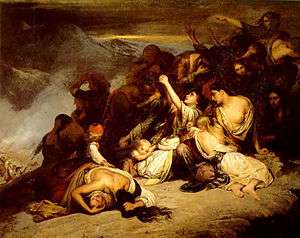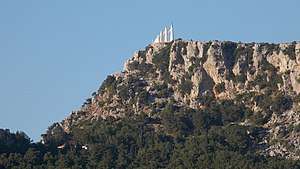Dance of Zalongo
The Dance of Zalongo refers to the mass suicide of women from Souli and their children during the Souliote War on December 16, 1803. After being trapped by Ottoman Albanian troops, near the village of Zalongo in Epirus, modern Greece, then Ottoman Empire, about 60 women decided to turn towards the cliff's edge together with their infants and children rather than surrender. According to tradition they did this one after the other while dancing and singing.[1][2] The name also refers a number of Greek theatrical dramas and a song in folk style, commemorating the event, named "Dance of Zalongo" (Greek: Χορός του Ζαλόγγου, Horos tou Zalongou).[3] There is also a similar Cham Albanian dance-song called Vallja e Zallongut ("Dance of Zalongo").[4][5]

History

During the Souliote War in December 1803, the Souliotes began evacuating Souli after their defeat by the forces of the local Ottoman-Albanian ruler, Ali Pasha.[6] During the evacuation, a group of Souliot women and their children were trapped by Ali's troops in the mountains of Zalongo in Epirus.[6] In order to avoid capture and enslavement, the women threw their children first and then themselves off a steep cliff, committing suicide.[7] The incident is also mentioned by Christoforos Perraivos in his 1815 edition of the History of Souli and Parga.[8] According to the legend, they jumped down the precipice one after the other while singing and dancing.[9] The incident soon became known across Europe. At the Paris Salon of 1827, the French artist Ary Scheffer exhibited two Romantic paintings, one of which was entitled Les Femmes souliotes ("The Souliot Women").[10] Today, the Zalongo Monument on Mount Zalongo in Kassope commemorates their sacrifice.[11]
Theatricals and Songs
There is a popular Greek dance-song about the event, which is known and danced throughout Greece today.[12] It was part of popular drama, written by Sp. Peresiades, published in 1903 and staged first in 1904.[13] The Greek folk song "Dance of Zalongo" has the following lyrics:
| English | Greek |
|---|---|
Farewell poor world, |
Έχε γεια καημένε κόσμε, |
Peresiadis describes this part of his drama as a "chorus of women", which can be translated as "dance", but in that context it possibly means a "group of women", as that in ancient Greek drama.[14]
An Albanian dance-song called Vallja e Zallongut ("Dance of Zalongo") was developed with lyrics that refer to the same aforementioned mass suicide, published in 1961 by Sako Zihnni:[5]
| Albanian | English |
|---|---|
Lamtumirë, o Sul, i shkretë, |
Goodbye, oh desolate Souli, |
References
- Nikolopoulou, Kalliopi (2013). Tragically Speaking On the Use and Abuse of Theory for Life. Lincoln: UNP - Nebraska Paperback. p. 239. ISBN 9780803244870.
- Karanikas, Dr. Alex. "The Dance of Zalongo". Hellenic Communication Service. Retrieved 21 June 2016.
- Royal Society of Canada 1943, p. 100; International Folk Music Council 1954, p. 39.
- Sako 1961.
- Mero Rrapaj, Fatos (1983). Këngë popullore nga Çamëria [Popular songs from Chameria]. Akademia e Shkencave e RPS të Shqipërisë, Instituti i Kulturës Popullore. p. 451. "Kjo është «Vallja e Zallongut». Siç dihet, pjesa me e madhe e suljotëve (që s’mundi të hidhej në Korfuz me Foto Xhavellën), e nisur për në Pargë, ndeshet në fillimet e vitit 1804 me forcat e Ali Pashës. Mjaft prej tyre nuk pranojnë të dorëzohen dhe vazhdojnë luftën gjersa shfarosen, ndërsa një grup grash suljote për të mos renë në duar të armikut, në çastin e fundit, dredhin e këndojnë këtë valle lamtumirë, dhe njëra pas tjetrës me fëmijët në krahë hidhen në greminë nga shkëdmbenjt e Zallongut, duke u bërë copë-copë. [This is the «Dance of Zalongo». As is known, the majority of the Souliotes (who could not go across to Corfu with Photos Tzavella), started to go toward Parga, encountered at the beginning of 1804 the forces of Ali Pasha. Many of them refused to surrender and continued to fight until they were destroyed, while a group of Souliote women not fallen into the hands of the enemy, at the last minute, they sung this dance of goodbye, and one after the other children in their arms were thrown into the abyss upon the rocks of Zalongo, becoming pieces.]"
- Sakellariou 1997, pp. 250–251.
- Royal Society of Canada 1943, p. 100; International Folk Music Council 1954, p. 39; Papaspyrou-Karadēmētriou, Lada-Minōtou & Ethniko Historiko Mouseio (Greece) 1994, p. 47; Pritchett 1996, p. 103.
- Fenerli-Panagiotopoulou Aggeliki, "The theatrical play 'Souliotes' (1809-1827) ", Eranistis 15/16, p. 161 In Greek. The publication refers to a theatrical play, first staged in 1816 in Odessa.
- International Folk Music Council 1954, p. 39; Mynatt & Kaiman 1968, p. 28.
- Athanassoglou-Kallmyer 1989, p. 102.
- Pritchett 1991, p. 219 (Footnote #326); Pritchett 1996, p. 103.
- International Folk Music Council 1954, p. 39.
- Spyridon Peresiadis, "The Dance of Zalongo", Athens, 1903 (Σπυρίδων Περεσιάδης, Ο χορός του Ζαλόγγου, εκδ. Γεώργιου Φέξη)
- Irene Loutzaki, "The Dance of Zalongos: an invented tradition on canvas?" in Barbara Sparti et al. (eds.) "Imaging dance. Visual Representations of Dancers and Dancing", pre-edition version, 2011, p. 7
Sources
- Athanassoglou-Kallmyer, Nina M. (1989). French Images from the Greek War of Independence (1821-1830): Art and Politics under the Restoration. New Haven, Connecticut: Yale University Press. ISBN 0-300-04532-8.CS1 maint: ref=harv (link)
- International Folk Music Council (1954). Journal of the International Folk Music Council, Volumes 6-10. Cambridge, England: Published for the International Folk Music Council by W. Heffer & Sons.CS1 maint: ref=harv (link)
- Mynatt, Constance Virginia; Kaiman, Bernard D. (1968). Folk Dancing for Students and Teachers. Dubuque, Iowa: Wm. C. Brown Co.CS1 maint: ref=harv (link)
- Papaspyrou-Karadēmētriou, Euthymia; Lada-Minōtou, Maria; Ethniko Historiko Mouseio (Greece) (1994). The National Historical Museum. Athens, Greece: Historical and Ethnological Society of Greece. ISBN 960-85573-0-5.CS1 maint: ref=harv (link)
- Pritchett, William Kendrick (1996). Greek Archives, Cults, and Topography. Amsterdam, The Netherlands: J.C. Gieben. ISBN 90-5063-147-9.CS1 maint: ref=harv (link)
- Pritchett, William Kendrick (1991). The Greek State at War, Volume 5. Berkeley, California: University of California Press. ISBN 0-520-07374-6.CS1 maint: ref=harv (link)
- Mero Rrapaj, Fatos (1983). Këngë popullore nga Çamëria [Popular songs from Chameria]. Tirana, Albania.: Akademia e Shkencave e RPS të Shqipërisë, Instituti i Kulturës Popullore.CS1 maint: ref=harv (link)
- Royal Society of Canada (1943). Mémoires de la Société Royale du Canada. Ottawa, Canada: Royal Society of Canada.CS1 maint: ref=harv (link)
- Sakellariou, M. V. (1997). Epirus: 4000 Years of Greek History and Civilization. Athens, Greece: Ekdotike Athenon. ISBN 960-213-371-6.CS1 maint: ref=harv (link)
- Sako, Zihni, ed. (1961). Mbledhës të Hershëm të Folklorit Shqiptar (1635-1912). Tirana, Albania: Instituti i Folklorit, Sektori i Folklorit Letrar.CS1 maint: ref=harv (link)